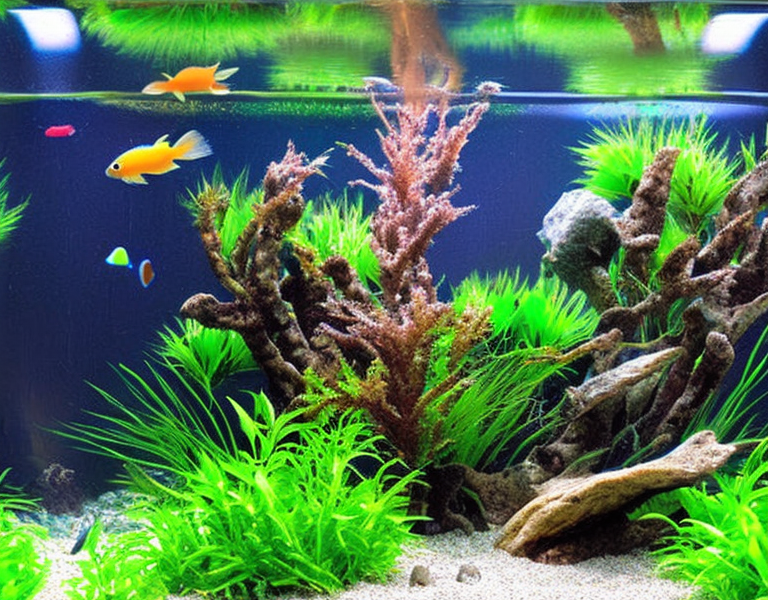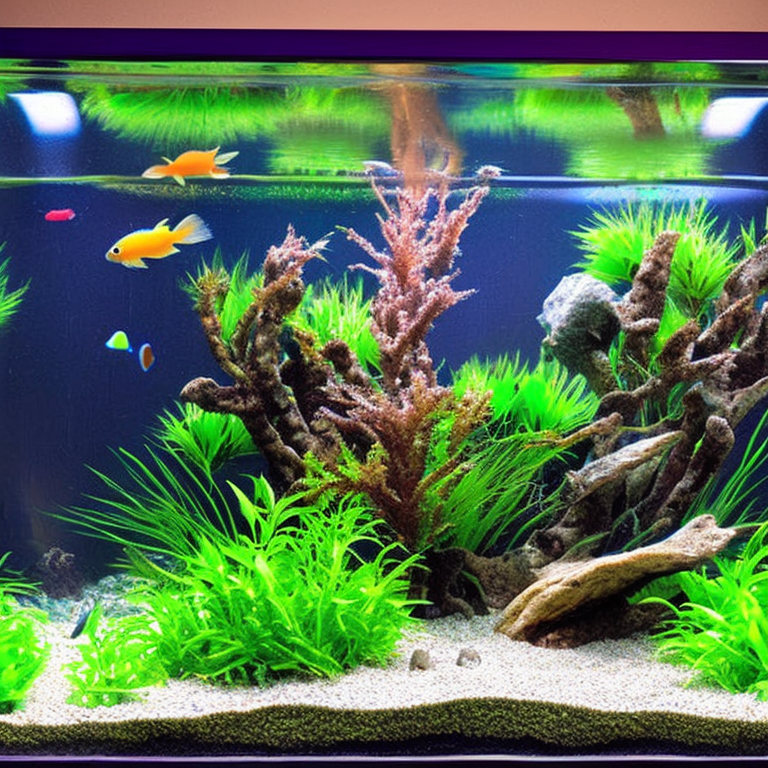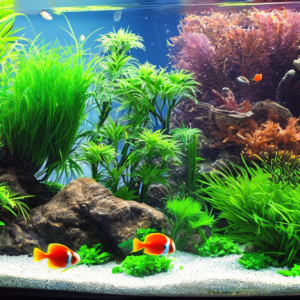
Keeping Tropical Fish: A Beginner’s Guide
Keeping Tropical Fish: A Beginner’s Guide
For many, the pastime of keeping tropical fish is both fulfilling and entertaining. Whether you are a beginner or an experienced aquarist, there are a few things to remember when setting up and maintaining your aquarium.
Firstly, choosing the right size tank for the type and number of fish you plan to keep is essential. Make sure you learn about the unique requirements of each fish species before buying any, as overcrowding can cause water pollution and stress for the fish.
You must test the water and change it regularly to keep things steady. It is also essential to properly cycle your tank before adding fish to ensure that beneficial bacteria have established themselves to break down waste and prevent harmful ammonia and nitrite spikes.
Overall, keeping tropical fish can be a fulfilling and fascinating hobby with the right equipment, knowledge and care.
Essentials of Tropical Fishkeeping
Choosing the Right Aquarium
When it comes to tropical fishkeeping, choosing the right aquarium is crucial. A good rule of thumb is to select a tank holding at least 20 gallons of water. This should provide enough space for your fish to swim around comfortably. Ensure that the aquarium is large enough to accommodate them.
Glass is a popular choice as it is sturdy and scratch-resistant. Acrylic is another option that is lightweight and more durable than Glass, but it can be prone to scratches.
Water Quality and Parameters
Maintaining proper pH, ammonia, nitrite, and nitrate levels in the water requires frequent testing. Ensure no ammonia or nitrite is present and the pH stays between 6.5 and 7.5. Restrict nitrate levels to less than 40 parts per million.
Changing 10-20% of the water weekly is a good rule of thumb.
Heating and Filtration Systems
Tropical fish require a consistent temperature range of 75-82°F (24-28°C) to thrive. You should also consider the type of filtration system you use. A sound filtration system will help remove excess waste and clean the water.
Several types of filtration systems are available, including power filters, canister filters, and sponge filters. Power filters are the most common and are easy to use and maintain. A canister filter is the way for larger aquariums because of its increased power. A sponge filter might be the way to go if you have a smaller aquarium and are short on time or energy.
Selecting Tropical Fish
When selecting tropical fish for your aquarium, several factors must be considered to ensure that your fish thrive in their environment. Here are some essential things to keep in mind:
Species Compatibility
Make sure the fish you chose get along well with one another. Some fish are territorial and aggressive, while others are peaceful and prefer to school. Research your desired species and their temperament to ensure they coexist peacefully in your aquarium.
Fish Size and Growth Expectations
Consider the size of your aquarium and the growth expectations of your chosen fish. It is recommended to have a larger tank for certain species because of their potential for significant growth. Be mindful of the adult size of your fish and plan accordingly to avoid overcrowding and stress.
Dietary Requirements
The ideal food for tropical fish varies from species to species. Some are herbivores, while others are carnivores or omnivores. Research the dietary needs of your chosen species and ensure that you provide them with the appropriate food to keep them healthy.
By considering species compatibility, fish size and growth expectations, and dietary requirements, you can select the right tropical fish for your aquarium and make sure your fish are happy and healthy.
Aquarium Setup and Maintenance
Cycling Your Aquarium
Cycling involves establishing a colony of beneficial bacteria in the filter media to break down the harmful ammonia and nitrite produced by fish waste. This process can take several weeks, so be patient and avoid adding fish until the cycle is complete.
Toss in some ammonia from fish food or straight ammonia to the water to cycle your aquarium. Regularly check the water for ammonia and nitrite levels using a test kit. Once ammonia levels begin to decrease and nitrite levels begin to rise, the cycle is well underway. Keep adding ammonia until both ammonia and nitrite levels drop to zero. The cycle is complete now; you can safely add fish to your tank.
Regular Cleaning Schedule
Regular care is essential for keeping an aquarium clean and healthy. A 10-20% weekly water change is recommended to remove built-up waste and replenish essential minerals and nutrients. Use a gravel hoover substrate to clear the base of any debris, and clean the filter medium often to keep it in good working order.
It is also essential to regularly monitor the water temperature, pH, and other water parameters using a test kit. Any significant changes in these parameters can harm your fish, so it is crucial to address them promptly.
Aquascaping and Decoration
Aquascaping and decoration can play an essential role in the health and happiness of your tropical fish. Provide plenty of hiding places and areas for fish to explore, such as caves, plants, and driftwood. Avoid overcrowding the tank and ensure plenty of open swimming space for your fish.
Water oxygenation and natural filtration are two benefits plants can offer, but be sure to choose plants suitable for your aquarium setup and lighting conditions. Avoid using decorations that may harm your fish, such as sharp or rough objects.
Following these easy steps, you can provide a lively and healthy habitat for your tropical fish.
Health and Wellbeing of Fish
Common Diseases and Treatments
There are several diseases that tropical fish can get, some of which can be deadly if not treated quickly. Common diseases include fin rot, ich, and dropsy. White patches appear on the body of infected fish, while fin rot causes the fins and tail to deteriorate progressively. Dropsy, on the other hand, causes the fish to swell up due to fluid buildup.
Isolate the sick fish immediately and give it medicine if you see any disease symptoms. Maintaining good water quality and avoiding overfeeding is essential because fish are more likely to get sick in water that isn’t ideal for them.
Stress Prevention
Additionally, stress can have a significant role in determining your fish’s overall health. Factors that can cause stress include overcrowding, aggressive tankmates, and sudden water temperature or chemistry changes. To prevent stress, make sure your fish have plenty of space to swim and hide and pick fish that are similar to each other in size and personality. Gradually acclimate new fish to your tank’s water conditions to avoid shock.
Quarantine Procedures
To keep an eye out for any symptoms of illness, it’s best to keep the new fish in a quarantine tank that mimics your primary aquarium. Treat them with medication if necessary before introducing them to your main tank.
In conclusion, maintaining the health and wellbeing of your tropical fish requires careful attention to their physical and emotional needs. Following these guidelines can help prevent disease, reduce stress, and ensure your fish live long and happy lives.
Advanced Considerations
Breeding Tropical Fish
Breeding tropical fish can be a rewarding experience for experienced fish keepers. However, it requires a significant amount of knowledge and preparation. Before attempting to breed your fish, research the specific breeding requirements of the species you are interested in. Some species require specific water conditions, lighting, and diet to breed successfully.
It is also essential to have a suitable breeding tank set up. This should be separate from your main aquarium and have appropriate filtration and heating. Additionally, you may need to introduce specific plants or decorations to provide hiding places and breeding sites for your fish.
Live Plants in the Aquarium
Adding actual plants to your aquarium may provide several benefits, such as better water quality, excellent oxygen, and a more authentic setting for your fish. However, it is essential to choose the right plants for your aquarium and provide appropriate care to ensure their health and growth.
When selecting plants, consider the lighting and nutrient requirements of the species you are interested in. Some plants require high light levels and specific nutrients, while others may thrive in lower light conditions. Additionally, be sure to choose plants compatible with the fish in your aquarium that will not be uprooted or damaged by their activity.
Advanced Filtration Techniques
Advanced filtration techniques can help to maintain optimal water quality in your aquarium and reduce the risk of disease and other health issues for your fish. A protein skimmer is one way to prevent the breakdown of organic waste in water, which could produce toxic chemicals.
Another option is to use a refugium, a separate compartment within your filtration system that provides a habitat for beneficial microorganisms and other organisms that can help break down waste and maintain water quality. You may also consider using a UV sterilizer to help eliminate harmful bacteria and parasites from the water.
If you want your fish to be healthy, you should utilise modern filtration methods, change the water often, and do other maintenance duties.
Community and Resources
Joining Fishkeeping Forums
Joining a fishkeeping forum is a terrific opportunity to meet other fishkeeping enthusiasts, share experiences, and learn more about tropical fishkeeping if you’re new to it. Many forums are available online, each with its unique community and focus. Some popular options include Fishforums.net, TropicalFishKeeping.com, and TheFishTankForum.com.
You can learn much from other fish keepers’ experiences and insights if you join a forum and post your queries there. You can also browse through existing threads to find answers to common questions or learn about new fish species and aquarium equipment.
Books and Magazines
There are many books and magazines available that can help you learn more about keeping tropical fish. Some popular options include Practical Fishkeeping, Tropical Fish Hobbyist, and The Complete Aquarium Guide. These resources can provide in-depth information on everything from fish species and aquarium setup to water chemistry and disease prevention.
When choosing a book or magazine, look for one that is well-reviewed and written by a reputable author or publisher. Consider subscribing to a magazine to receive regular updates and advice.
Local Fishkeeping Clubs
Joining a local fishkeeping club can be a great way to meet other enthusiasts in your area and learn from their experiences. These groups often get together for gatherings where they can talk about anything that interests them and show off their newest aquarium creations. Some clubs also organize events like fish swaps and auctions, where members can buy and sell fish and aquarium equipment.
Search online or with your local pet store for a local fishkeeping club. Consider starting your club if there isn’t one in your area. By connecting with other enthusiasts, you can learn more about the hobby and build a supportive community of fellow fish-keepers.
The post Keeping Tropical Fish: A Beginner’s Guide appeared first on Unity Pets.
The Article Keeping Tropical Fish: A Beginner’s Guide was found on https://limitsofstrategy.com
The Article Keeping Tropical Fish: A Beginner’s Guide First Appeared ON
: https://ad4sc.com













